
In-Depth | Battle for Jatland: How the poll contest is stacked up in west UP

In-Depth | Battle for Jatland: How the poll contest is stacked up in west UP
Jatland, a reference to the Jat-dominated sugarcane belt of western Uttar Pradesh, is witnessing a high-voltage electoral contest that is primarily shaped up between the ruling Bharatiya Janata Party (BJP) and the alliance of Rashtriya Lok Dal (RLD) and Samajwadi Party (SP).
The region largely goes to polls in the first phase of assembly elections on February 10, and a few of the other seats where Jat votes can be decisive will be contested in the second round on February 14.
Since 2014, the BJP has emerged as western UP's dominant electoral player, registering a clean sweep victory in two successive parliamentary polls and the last assembly elections.
The saffron camp, however, faces an uphill task this time, primarily due to two factors - the anger over the central farm reform laws that were scrapped only after a year-long protest, and the blurring of divisions between Muslim and Jat communities, experts say.
The pending dues of sugarcane farmers, the non-addressal of demands related to minimum support price (MSP) for crops, and the "death of around 700 farmers" in the anti-farm law protests last year add to the ruling party's woes.
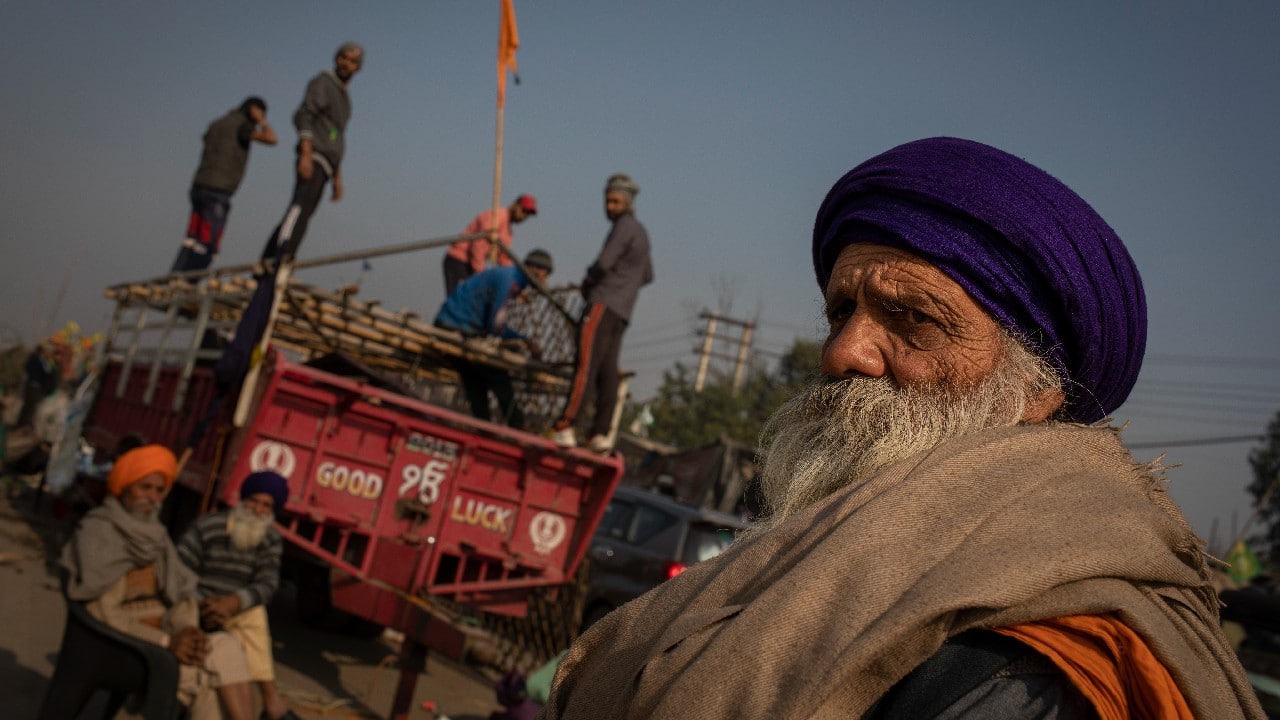 Western UP was one of the epicentres of the farmers' protest. The controversial farm reform laws were eventually repealed by the Centre in November 2021 (Image: AP)
Western UP was one of the epicentres of the farmers' protest. The controversial farm reform laws were eventually repealed by the Centre in November 2021 (Image: AP)

Predominantly a farming community, Jats are also known for asserting themselves strongly in the political sphere.
The community is believed to account for nearly one-fourth of Haryana's population, and has a significant presence in the bordering districts of Rajasthan, along with western UP.
A number of states, including UP, Madhya Pradesh, Himachal Pradesh and Rajasthan, have placed them on the list of Other Backward Classes (OBC). The community, however, has demanded its inclusion in the central OBC list as well.
In Uttar Pradesh, political observers differ in their estimation related to the influence of Jat voters due to two factors: first, the area under western UP is not defined under a political map, which allows analysts to include or exclude a few of the districts; and second, the exact Jat population is not known as the last caste-based census was conducted way back in 1934.
According to psephologists, the Jat population ranges from 12-15 percent if the 70-80 assembly segments of western UP are taken into account.
But their numbers per constituency shoot up to 35 percent if the definition of west UP is restricted to the 30 to 40 constituencies that are spread across the districts of Baghpat, Muzaffarnagar, Shamli, Bijnore, Meerut, Aligarh, Mathura and Moradabad.
"If we narrow down the definition of western UP to 40 constituencies, then the proportion of Jat votes will increase dramatically. It can reach 30-35 percent in many of these constituencies. But, in a larger definition of western UP that relates to 75-76 constituencies, then their population is estimated as 12-13 percent," said Sanjay Kumar, co-director of research programme Lokniti at the Centre for the Study of Developing Societies (CSDS), while speaking to Moneycontrol.
Pollsters, by referring to western UP, generally draw attention towards the chunk of 35-40 seats where Jat votes decide the outcome, he explained, adding that this is what makes the Jat factor crucial.
"There is absolute concentration. You will not find a single caste numerically so strong (in one region). The other castes in UP - Brahmin, Yadav, Dalits and others - are scattered in all parts of the state. But Jats are heavily concentrated in these 35-odd seats. This is the reason why polls in western UP revolve around the Jat factor," Kumar added.
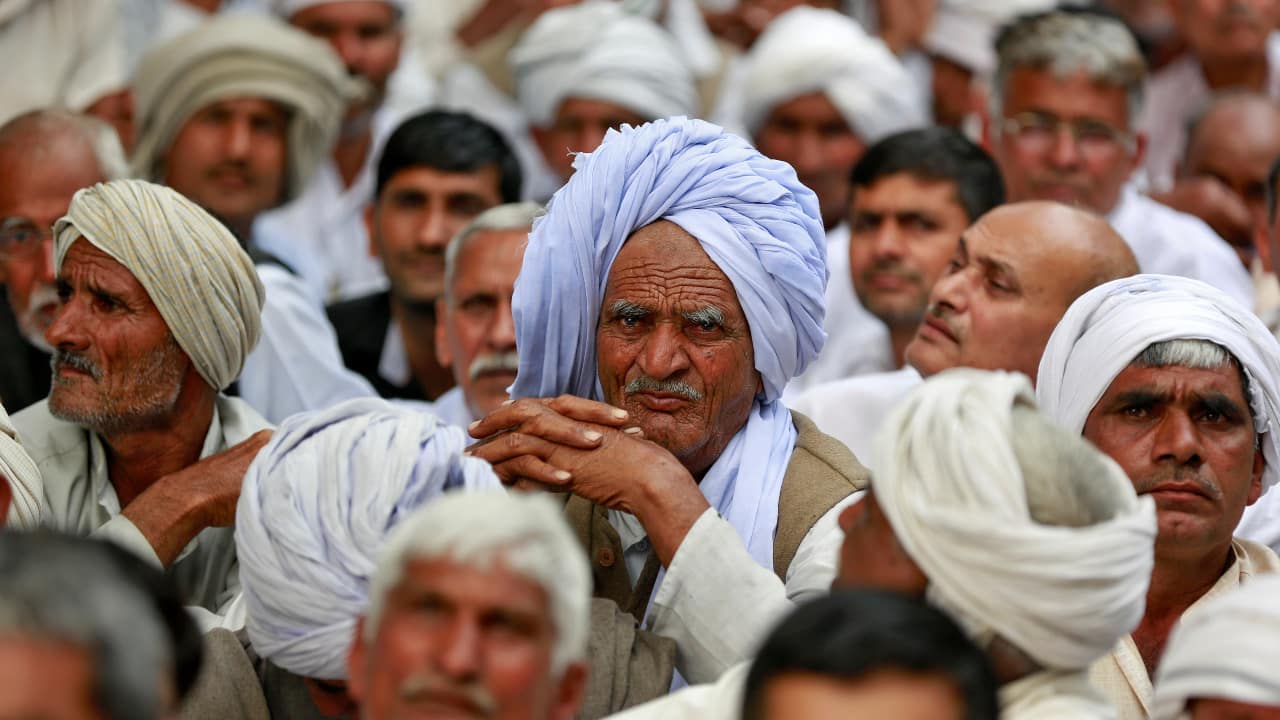 Jats are a predominantly farming community, with a high share in western UP's population (File image: Reuters)
Jats are a predominantly farming community, with a high share in western UP's population (File image: Reuters)

Two of the tallest mass leaders who emerged from UP's sugarcane belt, in the post-independence years, were the late former prime minister Chaudhary Charan Singh and the late farmer union leader Mahendra Singh Tikait.
Charan Singh became the first non-Congress chief minister of UP in 1967, and reclaimed the post in 1970. His brand of politics equally opposed the Jan Sangh - the BJP's predecessor - and allowed him to bring Jats and Muslims of western UP on a common political platform, experts point out. He later became the prime minister for a six month-period between 1979 and 1980.
Mahendra Tikait, who led the Bharatiya Kisan Union (BKU), held massive agrarian protests in 1980s and 1990s - including the dharna of 5 lakh farmers outside the Parliament in 1988 that had brought the national capital to a standstill.
Singh and Tikait's legacy holds significance to the politics of western UP till date. The RLD, the ally of SP which recently received a veiled invitation from the BJP to switch over, is currently led by Singh's grandson Jayant Chaudhary. On the other hand, Tikait's son Rakesh Tikait was, arguably, the face of the farmers' agitation last year that led to the scrappage of farm reform laws.
 For his pro-farmer politics, Charan Singh had earned the tag of 'champion of peasants' (Image: PIB)
For his pro-farmer politics, Charan Singh had earned the tag of 'champion of peasants' (Image: PIB)After the demise of Singh in 1987, his IIT-educated son Ajit Singh and the then Janata Dal leader Mulayam Singh Yadav collided in a bid to wrest the party's leadership.
Yadav emerged as the dominant electoral player of Uttar Pradesh, whereas, Ajit Singh kept altering political sides. He was part of the VP Singh-led central government in 1989, but defected to the Congress in 1996.
In 1999, he formed the RLD, which bagged two Lok Sabha seats - Baghpat and Kairana - that year. In 2002, the party allied with the BJP and won 14 out of the 38 assembly seats it contested. This remains the highest number of seats ever won by the RLD.
In 2007, it went solo and won only 10 assembly seats. Since then, RLD's electoral graph has been sliding, dropping to nine in 2012 and only one in 2017. Its lone MLA later joined the BJP. In 2019, both Ajit Singh and son Jayant Chaudhary lost in the parliamentary polls.
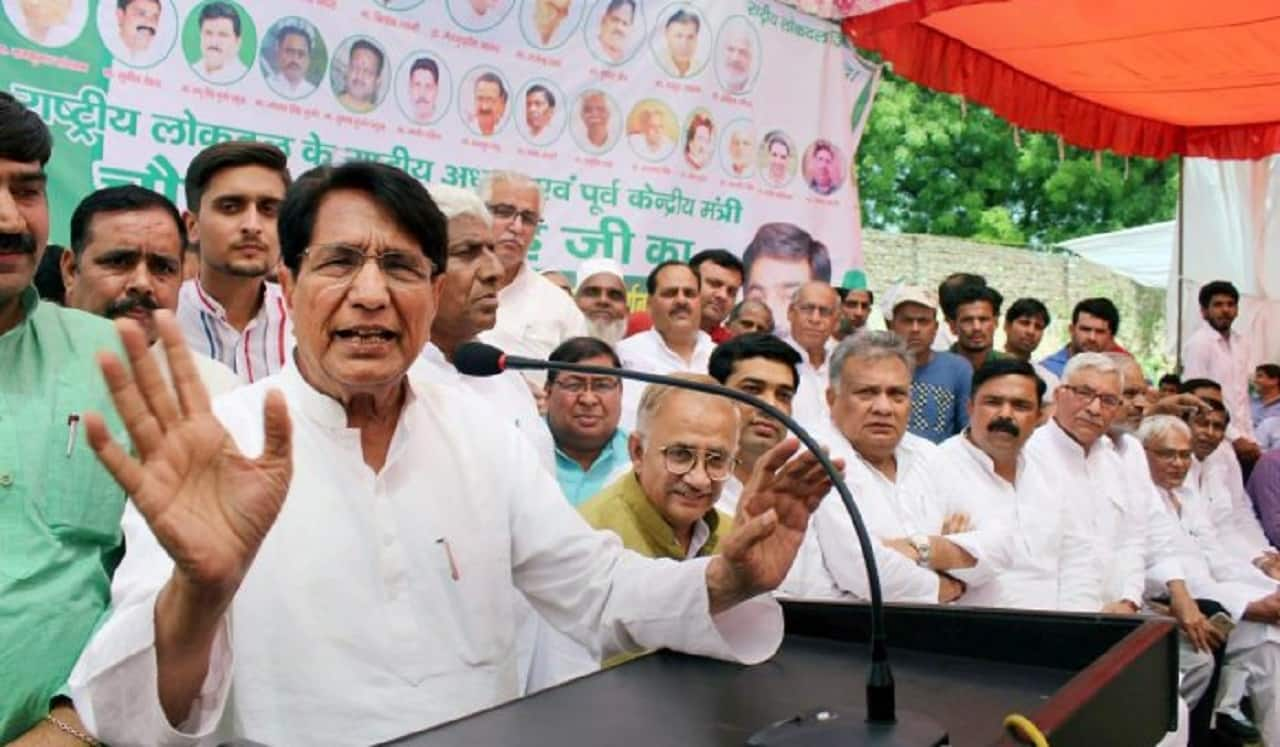 Ajit Singh, also a former union minister, died on May 6, 2021, after being infected with COVID-19. He was aged 82. (File Image: PTI)How west UP voted over the past decade
Ajit Singh, also a former union minister, died on May 6, 2021, after being infected with COVID-19. He was aged 82. (File Image: PTI)How west UP voted over the past decadeHere is a comparison on how political parties have, since 2012, performed in the larger frame of western UP, that includes 76 constituencies spread across the districts of Muzzafarnagar, Shamli, Meerut, Mathura, Aligarh, Bijnore, Bulandshahr, Sahranpur, Baghpat, Agra, Ghaziabad, Hapur, GB Nagar and Hathras.
In the assembly elections of 2012 and 2017| 2012 | 2017 | |
| BJP | 13 | 65 |
| BSP | 30 | 3 |
| SP | 18 | 5 |
| RLD | 8 | 1 |
| Congress | 6 | 2 |
| Others | 1 | 0 |
| *Data source: India Today | ||
The BJP, which was restricted to 13 seats in the 2012 assembly elections in this region, increased its tally to 65 constituencies in the 2017 polls.
The period between these two elections witnessed a leadership transition within the party, with Amit Shah, who took over as the BJP president in 2013, being credited for its meteoric surge in Uttar Pradesh.
The riots which erupted in Muzaffarnagar in 2013 also changed the political equations, and led to religion-based polarisation, analysts say.
In the parliamentary polls held in 2014, the BJP won all the nine Lok Sabha seats of western UP. The party's vote share among Jats increased to 77 percent, as per the post-poll analysis of Lokniti-CSDS.
In 2019, the BJP retained eight of the nine western UP Lok Sabha seats -- the exception being Saharanpur which was wrested by the BSP. The party's vote share among the Jat community, however, further increased to 91 percent, according to Lokniti-CSDS.
| 2014 | 2019 | |||
| Political Party | West UP Seats | Jat Vote Share | West UP Seats | Jat Vote Share |
| BJP | 9 | 77% | 8 | 91% |
| Congress | 0 | 13% | 0 | 2% |
| SP | 0 | 4% | - | - |
| BSP | 0 | 6% | - | - |
| Mahagathbandhan (SP+BSP+RLD) | - | - | 1 | 7% |
| *SP, BSP and RLD contested under Mahagathbandhan alliance in 2019. *Vote share data source: Lokniti-CSDS | ||||
 File image of PM Modi with Yogi Adityanath and other UP BJP leaders (Image: Twitter/@narendramodi)
File image of PM Modi with Yogi Adityanath and other UP BJP leaders (Image: Twitter/@narendramodi)

One of the reasons why the BJP was able to expand its electoral footprint in western UP, claim experts, was the deep fissures that developed between the Jat and Muslim communities following the 2013 Muzaffarnagar riots.
According to Kumar, the year-long agrarian protest has pitted the Jat community against the BJP and brought them, to a significant extent, on the same page with the Muslims.
"I am not sure whether the two communities can bury their differences, but, at the moment, they have a common enemy to target. That brings them together to a great extent," he said.
The Muslim population in the region averages at around 24 percent, the psephologist claimed, adding that the community, combined with the Jat voters, may tilt the elections in favour of the SP-RLD in western UP.
The two communities "may not be coming together in a very enthusiastic way, but they have started to realise that they must get united if they want the BJP to be defeated", he added.
"I think their votes will get polarised in a big way in favour of the RLD. And, whether that will be enough for the Akhilesh Yadav-led alliance to reach the magic figure, is a different story," the Lokniti-CSDS co-director further said.
 SP president Akhilesh Yadav and RLD chief Jayant Chaudhary announced their alliance in November last year (Image: Twitter/@yadavakhilesh)
SP president Akhilesh Yadav and RLD chief Jayant Chaudhary announced their alliance in November last year (Image: Twitter/@yadavakhilesh)
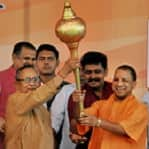
The BJP is aggressively resorting to Hindutva politics, with the intent to minimise caste-based divisions among the voters, point out experts.
The party has also come under criticism from some quarters for a number of contentious statements, including Chief Minister Yogi Adityanath's claim that the election is a contest between "80 percent and 20 percent".
The saffron-robed politician's remark was described as "blatantly communal" by the Opposition, which accused him of portraying the polls as a contest between the state's two religious communities. Adityanath, however, has maintained that he is "only referring to 80 percent of the population that will support him and 20 percent that will not".
Similarly, Adityanath's repeated use of "Abba Jaan" jibe while referring to SP patriarch and Akhilesh Yadav's father Mulayam Singh Yadav is being seen as an attempt to reinforce the party's pro-Muslim image.
While the Hindutva rhetoric may find traction in other regions of the state, it is unlikely to strike a chord this time in western UP, where the voters are predominantly focused on the "kisan (farmer) identity", analysts claim.
"In western UP, the context is different. The identity issue has become very strong. The identity of being a Muslim, the identity of being a Jat and the identity of being a farmer are the major factors. And the statements being made by BJP leaders is not being taken well by the people belonging to these identities," Kumar said.
For instance, when Adityanath said "yeh jo garmi dikh rahi hai Muzaffarnagar aur Kairana me, main May aur June me 'Shimla' bana deta hu" - which roughly translates that he could bring down the temperatures which are soaring these days in Muzaffarnagar and Kairana - it did not go down well among sections of the electorate, the expert claimed.
"The statement has drawn rebuttal from Jayant Chaudhary, the Jat leader, who said 'yes, we are born hot-blooded'. This suggests that not only the Muslims, but even Jats have not taken it well," Kumar said.
ये गर्मी जो अभी कैराना में और मुजफ्फरनगर में कुछ जगह दिखाई दे रही है न......मैं मई और जून की गर्मी में भी 'शिमला' बना देता हूं... pic.twitter.com/NoHJIxBLG9 — Yogi Adityanath (@myogiadityanath) January 30, 2022
According to political analyst Ravi Srivastava, the BJP is attempting to gain through religion-based polarisation "but the strategy is unlikely to yield success this time."
"From Muradnagar, Ghaziabad, up to Saharanpur, and from Bhatauli to Meerut, Shamli and Baghpat, farmers in both the agrarian belt are totally cut off from the BJP due to the central farm laws. They were repealed after 700 protesters lost their lives," Srivastava told Moneycontrol.
The mowing down of farmers in Lakhimpur Kheri, allegedly by Ashish Mishra, the son of BJP leader and Union Minister of State Ajay Mishra Teni, has "further infuriated the farmers", he further said.
"They are totally against the BJP. This is reflected on the ground when the BJP candidates are being shown black flags in villages," added Srivastava, who is also a co-founder of the Aam Aadmi Party but is not actively associated with it.
The Jat-farmer identity is also boosted through the popularity of BKU leader Rakesh Tikait, who has been constantly targeting the BJP. He has been warning the voters based in the region against communal polarisation.
"The (election) issues are farmers, unemployed youth and inflation for the middle class. But efforts are being made to polarise Hindu-Muslim voters through regular statements on Jinnah and Pakistan. But, this will not work out for those doing it and will instead harm them," Tikait told PTI in an interview in Lucknow on January 28.
 Rakesh Tikait, leader of the Bharatiya Kisan Union, carries farm reform law copies to burn them in a bonfire during the 'Holika Dahan' ritual at the Delhi-UP border in March 2021 (Image: Reuters)
Rakesh Tikait, leader of the Bharatiya Kisan Union, carries farm reform law copies to burn them in a bonfire during the 'Holika Dahan' ritual at the Delhi-UP border in March 2021 (Image: Reuters)However, questions were raised after Tikait's brother and BKU chief Naresh Tikait held a meeting with the BJP's Muzaffarnagar MP Sanjeev Balyan last month. Subsequently, the BKU had withdrawn support to the SP-RLD combine, saying they would not back any political front ahead of the polls.
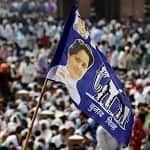
The BSP, which has a committed voter base among the Jatav Dalits, has proved to be a potent force in western UP in elections when the Muslim votes have swayed in its favour.
In 2012, despite trailing behind SP in most regions of the state, the Mayawati-led party had won 30 out of the 76 seats in west UP -- the highest among all parties.
In the parliamentary polls of 2019, her party candidate Haji Fazlur Rehman succeeded in winning from Saharanpur despite the BJP wave that swept most of western UP.
Despite emerging as the second runner-up in the opinion polls - behind the BJP and SP-RLD - the BSP has maintained that it would receive a silent endorsement from the voters "similar to 2007", when it had formed a single-party majority government.
Experts, however, feel the Mayawati-led party may fail to repeat the 2007 performance as it has not emerged as the prime challenger to the Yogi Adityanath-led BJP. The BSP supremo has been criticised for allegedly refraining from actively hitting the campaign trail.
Her first rally was held in Agra on February 2, barely eight days before the first phase of assembly elections. "It is too late now...the fight is between the BJP and the SP-RLD," Srivastava said.
"The BSP has become a spent force. Mayawati has failed to vociferously target the BJP. Despite having a significant number of lawmakers in the Rajya Sabha, she has not exercised her role as an Opposition leader strongly," he added.
If the BSP is not the dark horse in the poll race in western UP, will it play the role of a spoilsport? With a committed voter base and a high number of Muslim candidates, speculations are being raised whether the party can hurt the prospects the SP-RLD combine.
"There is a big question mark on this. In a normal election, the BSP would have severely damaged SP's vote share. But this election is a different ball game. This time, the Muslim community is expected to remain sharply polarised in favour of the Akhilesh-led alliance," Kumar said.
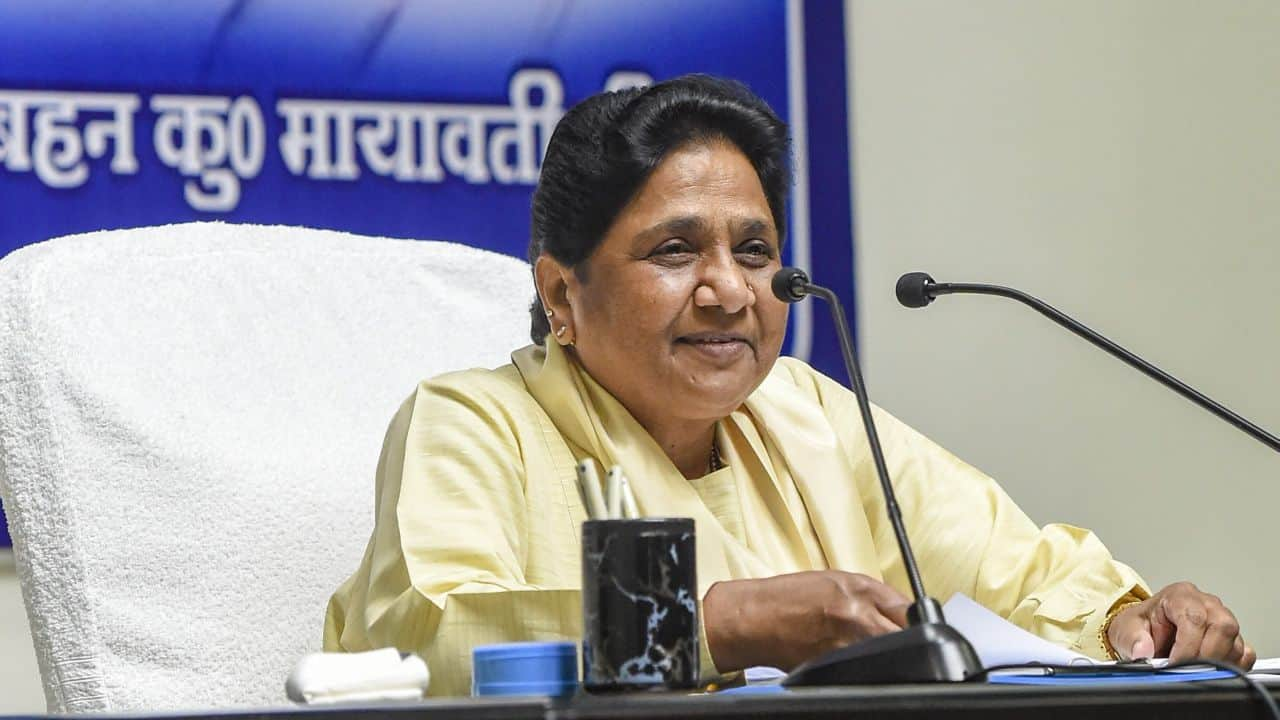 Mayawati, a four-time former UP CM, had ended her party's brief alliance with the SP following the lacklustre performance in the 2019 Lok Sabha polls. (File image: PTI)
Mayawati, a four-time former UP CM, had ended her party's brief alliance with the SP following the lacklustre performance in the 2019 Lok Sabha polls. (File image: PTI)While analysts have questioned Mayawati's approach towards the elections, the former chief minister has accused the media of falsely spreading the narrative that the BSP is invisible.
"All opinion polls, surveys will fail," she said in Agra on February 2, adding that the voters still remember the government that the BSP led between 2007 and 2012.
The cover image was created by Suneesh Kalarickal.Read more weekly in-depth articles from Moneycontrol here